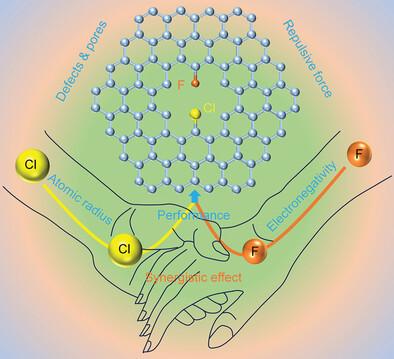Surface Charge Regulation of Graphene by Fluorine and Chlorine Co-Doping for Constructing Ultra-Stable and Large Energy Density Micro-Supercapacitors
IF 14.3
1区 材料科学
Q1 CHEMISTRY, MULTIDISCIPLINARY
引用次数: 0
Abstract
Settling the structure stacking of graphene (G) nanosheets to maintain the high dispersity has been an intense issue to facilitate their practical application in the microelectronics-related devices. Herein, the co-doping of the highest electronegative fluorine (F) and large atomic radius chlorine (Cl) into G via a one-step electrochemical exfoliation protocol is engineered to actualize the ultralong cycling stability for flexible micro-supercapacitors (MSCs). Density functional theoretical calculations unveiled that the F into G can form the “ionic” C─F bond to increase the repulsive force between nanosheets, and the introduction of Cl can enlarge the layer spacing of G as well as increase active sites by accumulating the charge on pore defects. The co-doping of F and Cl generates the strong synergy to achieve high reversible capacitance and sturdy structure stability for G. The as-constructed aqueous gel-based MSC exhibited the superb cycling stability for 500,000 cycles with no capacitance loss and structure stacking. Furthermore, the ionic liquid gel-based MSC demonstrated a high energy density of 113.9 mW h cm−3 under high voltage of up to 3.5 V. The current work enlightens deep insights into the design and scalable preparation of high-performance co-doped G electrode candidate in the field of flexible microelectronics.

通过氟和氯共掺杂调节石墨烯表面电荷以构建超稳定和大能量密度微型超级电容器
如何解决石墨烯(G)纳米片的结构堆叠以保持高分散性一直是促进其在微电子相关器件中实际应用的一个重要问题。在这里,通过一步电化学剥离协议将电负性最高的氟(F)和原子半径较大的氯(Cl)共同掺杂到石墨烯中,从而实现了柔性微型超级电容器(MSC)的超长循环稳定性。密度泛函理论计算揭示了在 G 中加入 F 可以形成 "离子 "C─F 键,从而增加纳米片之间的斥力,而 Cl 的引入可以扩大 G 的层间距,并通过在孔隙缺陷上积累电荷来增加活性位点。F和Cl的共掺杂产生了强大的协同作用,使G获得了高可逆电容和坚固的结构稳定性。所构建的水凝胶基MSC在500,000次循环中表现出极好的循环稳定性,且无电容损失和结构堆叠。此外,基于离子液体凝胶的 MSC 在高达 3.5 V 的高压下表现出 113.9 mW h cm-3 的高能量密度。目前的研究工作为柔性微电子领域高性能共掺杂 G 电极候选材料的设计和规模化制备提供了深刻的启示。
本文章由计算机程序翻译,如有差异,请以英文原文为准。
求助全文
约1分钟内获得全文
求助全文
来源期刊

Advanced Science
CHEMISTRY, MULTIDISCIPLINARYNANOSCIENCE &-NANOSCIENCE & NANOTECHNOLOGY
CiteScore
18.90
自引率
2.60%
发文量
1602
审稿时长
1.9 months
期刊介绍:
Advanced Science is a prestigious open access journal that focuses on interdisciplinary research in materials science, physics, chemistry, medical and life sciences, and engineering. The journal aims to promote cutting-edge research by employing a rigorous and impartial review process. It is committed to presenting research articles with the highest quality production standards, ensuring maximum accessibility of top scientific findings. With its vibrant and innovative publication platform, Advanced Science seeks to revolutionize the dissemination and organization of scientific knowledge.
 求助内容:
求助内容: 应助结果提醒方式:
应助结果提醒方式:


